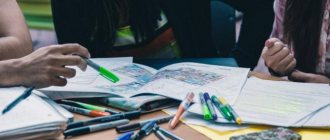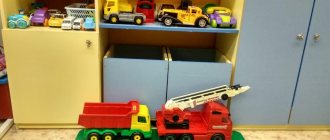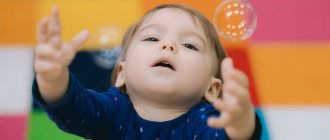MAGAZINE Preschooler.RF
Consultation “Experimentation in the first junior group”(from work experience)
This is my first year working on teaching experience.
We, teachers and parents of preschool children, want to see our children as inquisitive, sociable, independent, creative individuals who know how to navigate their surroundings. And this largely depends on us; work in this direction must begin from early preschool age. A preschool child is a researcher, showing a keen interest in various types of research activities, in particular in elementary experimentation.
Contents of children's research activities (younger preschool age)
Work with children is aimed at creating conditions for sensory development while familiarizing them with the phenomena and objects of the surrounding world. In the process of forming children’s research actions, teachers are recommended to solve the following tasks:
Combine showing the child with the child’s active action to examine him (palpation, taste, smell, etc.)
Compare objects that are similar in appearance.
Teach children to compare facts and conclusions from reasoning.
Use practical experience and gaming experience.
The main content of the research involves the formation of the following ideas:
- About materials (sand, clay, paper, fabric, wood).
- About natural phenomena (wind, snowfall, sun, water; games with the wind, with snow, etc.).
- About the world of plants (methods of growing from seeds, bulbs, leaves).
- About methods of studying an object.
- About the objective world.
In the process of research and experimentation, children's vocabulary develops through words denoting sensory features, properties, phenomena or objects of nature (color, shape, size); crumples, breaks; high - low - far; soft - hard - warm, etc.).
In the third year of life, visual and effective thinking reaches its maximum development. Manipulating objects begins to resemble experimentation. By continuing to enrich the child’s environment with more complex objects, the adult creates all the conditions for the development of his independence. The child must love to act and express this love with the words: “I want to do this , “I myself!” This is the main new formation of this age, which is important in the development of both experimentation and personality as a whole. If adults limit independent experimentation, then two outcomes are possible: either a passive personality is formed that does not need anything, or whims arise - a perverted form of realizing “I myself!” when the child did not have the opportunity to use the words “I want” .
By the end of the second year of life, all normally developing children should name all familiar objects and actions with them by their full names. By this time, they should have correct ideas about many objects and their parts, about the most common forms of animal behavior and about natural phenomena. All adult-led observations are short-term and carried out either individually or in small groups.
Children are already able to carry out certain simple tasks, therefore, they begin to perceive instructions and recommendations. However, they are not yet capable of independent work. An adult should always be nearby.
At this age, the ability to closely and purposefully examine objects and events first appears. This makes it possible to begin making simple observations (before this, the child did not observe, but simply looked). However, due to the instability of attention, the observation period is very short, and the adult must constantly take care to maintain interest in the chosen object.
By the age of three, all children master phrasal speech, therefore, you can ask them to answer simple questions. But they are not yet able to compose a story. As the field of activity of children expands, attention to compliance with safety rules increases.
In preschool educational institutions, experimentation can be organized in three main directions: specially organized training, joint activities of the teacher with children, and independent activities of children. It is important to remember that the lesson is the final form of research activity, which allows you to systematize children’s ideas.
Problem situations, heuristic tasks, experimentation can also be part of any lesson with children (mathematics, speech development, familiarization with the environment, design, etc.) focused on different types of activities (musical, visual, natural science, etc.)
An approximate algorithm for conducting an experiment lesson
- Preliminary work (excursions, observations, reading, conversations, examination, sketches) to study the theory of the issue.
- Determining the type of activity and subject of the experiment.
- Choosing the purpose of tasks for working with children (cognitive, developmental, educational tasks).
- Game training of attention, perception, memory, thinking.
- Preliminary research work using teaching aid equipment.
- Selection and preparation of aids and equipment, taking into account the age of the children of the topic being studied.
- Summarizing the results of observations in various forms (observation diaries, tables, photographs, pictograms, stories, drawings, etc.) in order to lead children to independent conclusions based on the results of the study.
I present to your attention my work experience on the topic “Children’s experimentation - as a method of cognitive development of preschoolers.
Preschool childhood is a very short period in a person’s life; during this period, cognitive activity develops intensively.
Cognitive activity is understood not only as a process of acquiring knowledge, skills and abilities, but, mainly, as a search for knowledge, acquiring knowledge independently or under the tactful guidance of an adult (Galina Mikhailovna. Lyamina, Alexandra Platonovna Usova, etc.). Knowledge acquired independently is always conscious and more durable. Nadezhda Aleksandrovna Korotkova points out: “Of course, a child learns about the world in the process of any of his activities, but it is in cognitive and research activities that a preschooler gets the opportunity to directly satisfy his inherent curiosity and practices in establishing connections between objects and phenomena, which allows him not only to expand, but also organize your ideas about the world .
In this regard, another effective method of understanding the patterns and phenomena of the surrounding world is being formed in the preschool education system - the method of experimentation.
The features of experimentation activities were studied in a number of studies by N.N. Poddyakov, Alexander Ivanovich Savenkov and others. Nikolai Nikolaevich Poddyakov points out that children's experimentation is a special form of search activity of preschool children, in which children's own activity is manifested, aimed at obtaining new information and new knowledge.
Experimentation acts as a teaching method if it is used to transfer new knowledge to children.
The main advantage of using the experimentation method in kindergarten is that during the experiment:
- Children get real ideas about the various aspects of the object being studied and its relationships with other objects and with the environment.
- The child’s memory is enriched, his thought processes are activated.
- Speech develops.
- There is an accumulation of a fund of mental skills.
- Independence, goal-setting, and the ability to transform any objects and phenomena to achieve a certain result are formed.
- The child’s emotional sphere and creative abilities develop, work skills are formed, and health is improved by increasing the overall level of physical activity.
Educators and psychologists point out that for the cognitive development of preschoolers, it is necessary to use children's experimentation.
At the same time, children's experimentation, as a form of search activity, is rarely used in the practice of preschool educational institutions, due to the following reasons:
- technologies for organizing children's experimentation are insufficiently developed
- educators experience difficulties when modeling cognitive cycle activities with elements of experimentation, because The existing publications mainly describe experiments and experimental games with various materials; they lack motivation for the child.
Thus, in practice, a contradiction has arisen between the need to develop children’s experimentation activities and the lack of technology for organizing this process, which led to the choice of the topic of my research and to the introduction of children’s experimentation into their practical activities.
Technology of experience.
My pedagogical work on organizing children's experimentation activities has been carried out for 10 years at the Lipitsa combined kindergarten "Kolosok" .
In our preschool educational institution there is an “Experimental Laboratory” , however, I have equipped an experimentation corner in our group so that children can satisfy their research interests at any time in free activity.
Our corner is constantly updated with new materials in accordance with the age of children and their interests.
The contents of the corner include: a “sand and water” zone, various vessels, natural and waste materials, different types of paper, magnifying glasses, magnets, pipettes, flasks, measuring spoons and cups, etc. various cereals, salt, sugar, candles, scoops, measuring cups. Not all materials are there at the same time.
To develop creative research activity in the process of children's experimentation, I constantly replenish our corner. New objects placed at children's disposal (for example, nets, strips of rubber, pieces of corrugated cardboard, etc.) encourage them to experiment with the use of these materials. This preserves children’s interest in this activity and develops curiosity.
Organization of children's experimentation.
While organizing children's experimentation, I came to the conclusion that it was necessary to draw up a long-term plan and develop additional notes on experimentation, taking into account the activity approach.
While observing the children, I identified objects of inanimate nature that aroused cognitive interest in children, and in accordance with this I compiled a list of activities and games for experimentation in the following sections: liquid, properties of water, air and its properties, conditions necessary for plant life, solid: sand, clay, soil, wood, iron, rubber, paper, glass, plastic, light: reflection of light, light sources, color: what is a rainbow, color mixing, sound, magnetism: magnet and its properties, magnifying glass.
Currently, since 2007, I have been using project activities to develop activities - experimentation, thanks to which children's experimentation is connected with other types of children's activities, and children form a holistic view of the world.
Some of the requirements for the content of the classes I develop are their focus on the interests and needs of children, connection with the life experience of the child, taking into account age and individual characteristics, subject-subject relations, creation of a problem field, active activity of children and motivation for activity.
I conduct specially organized experimentation classes based on independent note-taking and the use of notes from the work experience of other teachers.
In accordance with the process of developing the activity of experimentation, in my practice and when compiling notes, I put forward the following goals:
- develop children’s cognitive activity in the process of experimentation, through the creation of problem situations;
- lead children to formulate problems and analyze situations;
- develop the ability to plan your activities, put forward hypotheses, compare and draw conclusions;
- develop communication skills;
- help the accumulation and expansion of specific ideas in children about the properties of various objects of inanimate nature;
- promote the development of the ability to examine objects and phenomena from different angles, identify dependencies;
- develop the ability to organize your activities: select material, think through the course of activities;
Classes are conducted with small subgroups (from 7 to 12 children), which ensures the greatest cognitive and creative activity of each student, the opportunity to provide feedback and take into account the progress of each child.
To maintain interest in experimenting, I give children tasks and problem situations on behalf of the fairy-tale hero - Karkushi. She is small, and you can pass on your experience to the younger one and feel your significance, which strengthens the position of an “Adult” . It was interesting to watch how the children in the middle group put Karkusha in front of them and told her how to plant a bow correctly, or what can sink and what does not sink.
The process of developing children's experimentation is not limited to just one activity. In the free activity of children, exercises and problem situations are used that affect various objects of nature, or I connect to the already existing activities of children, the idea of which often arises as a momentary desire to act with something, to do something.
So while walking on the property, we notice that there is no grass on the paths. Why? We try to drip with a stick, and make sure that the ground on the paths is hard, and nearby - on the side of the road - it is loose. We came to the conclusion: since such soil cannot be excavated by a strong person, it means that it is difficult for weak plants to break through it. We continue our walk. So the experiment went unnoticed by the children.
At the end of the series of classes, to consolidate knowledge, we organize holidays and entertainment: “Meeting of the Snowman and the Iceman” ; "Journey to the magical land of Water" ; “Birthday of the Pond” , etc.
Stages of development of children's experimentation activities in accordance with the age of children.
Since interest in experimentation arises from an early age, I begin teaching children’s experimentation classes from the 2nd junior group.
With children 3-4 years old, children are prepared for experimentation.
With the help of game characters, children are presented with the simplest problem situations: Will a rubber ball sink? How to hide a ring in water from a fox? Why can't you eat snow? How to walk on ice without falling, etc.
In the second younger group, children master the actions of transfusion, pouring various materials and substances. Get acquainted with the properties of some materials and inanimate objects: water; sun rays; ice; snow; glass They learn about light sources, that if you shine light on an object, a shadow will appear; that different objects and animals make different sounds; and etc.
We conduct the following experiments: “Making koloboks” where children get ideas about what can be sculpted from wet sand. “Who will Droplet make friends with?” we introduce children to the fact that water can be clean or dirty, and is necessary for the life of plants, animals and people. "Magic Shadows" . Let us know that if you shine light on an object, a shadow will appear. "Multi-colored pieces of ice" . We give an idea that ice is frozen water. And etc.
At this age, when experimenting, I set the goal of the experiment, help the children think through a plan for its implementation, and together with the children I carry out the necessary actions. I gradually involve children in predicting the results of their actions: “What will happen if we blow on a dandelion?”
I teach children to select and find the necessary materials and equipment, perform simple actions, see the result of the activity, thereby developing the children’s own research activity.
So, for example, in the lesson “Hide the Ring” , children became acquainted with the properties of water - transparency, colorlessness, and can change color.
Acting as a partner, I figure out with the children how to hide the ring in a glass of water, and clarify what is needed for this. Then we check all the ways to solve the problem proposed by the children. Next, we plan our activities: for example: let’s wrap a glass in paper, but there is none, then we’ll tint the water with paints. Let's find out what color paint suits best to hide the ring. During the activity, we discuss the actions being performed and what is happening.
Then we draw conclusions together: The water was without color, and then it became colored, multi-colored, the water can change color. The water was clear, but became opaque. And etc.
Interaction with families of pupils on the development of children's experimentation.
In order to increase the pedagogical literacy of parents, I systematically conduct consultations on the research activities of preschoolers.
To maintain children's interest in experimentation, I recommend that parents create experimentation corners at home. To do this, I constantly update visual information on conducting research activities.
I involve parents in designing the experimentation corner in the group.
After holding meetings and consultations, parents and children began conducting experiments at home.
Interaction with parents increased their interest in their child’s research activities. Parents are more willing to turn to teachers for help and share their impressions.
Conclusion.
As a result of organizing children's experimentation, I came to the conclusion that children develop cognitive activity and become interested in search and research activities.
The horizons broaden, in particular, the knowledge about living nature and the interrelations of what happens in it is enriched; about objects of inanimate nature (water, air, sun, etc.) and their properties; about the properties of various materials (rubber, iron, paper, glass, etc.), about their use by humans in their activities.
Children develop skills in planning their activities, the ability to put forward hypotheses and confirm assumptions, and draw conclusions.
Personal qualities develop: independence, initiative, creativity, cognitive activity and determination.
Experimental work arouses children's interest in exploring nature and stimulates them to acquire new knowledge.
Thus, I came to the conclusion that experimentation as a specially organized activity contributes to the formation of a holistic picture of the world of a preschooler and the foundations of his cultural knowledge of the world around him.
The system for developing children's experimentation activities, developed and tested in practice, has proven its effectiveness in the cognitive development of preschoolers.
| Next > |
What to plant in the garden in kindergarten?
From vegetable plants in the garden
grow: lettuce, spinach, radishes, onions, parsley, peas, cabbage (white, red, cauliflower, kohlrabi, carrots, turnips, beets, cucumbers, tomatoes, zucchini, pumpkin, squash, sorrel, celery, dill, rhubarb (perennial plant) ).
Interesting materials:
Sick leave at whose expense? Which brokerage or investment account should I open? What is BSO? How to decorate sandwiches with caviar? Household services, what do they include? What is a bear afraid of in the forest? Whose domain is ICU? Whose domain is us? Whose AvtoVAZ is it now? Someone's case?


